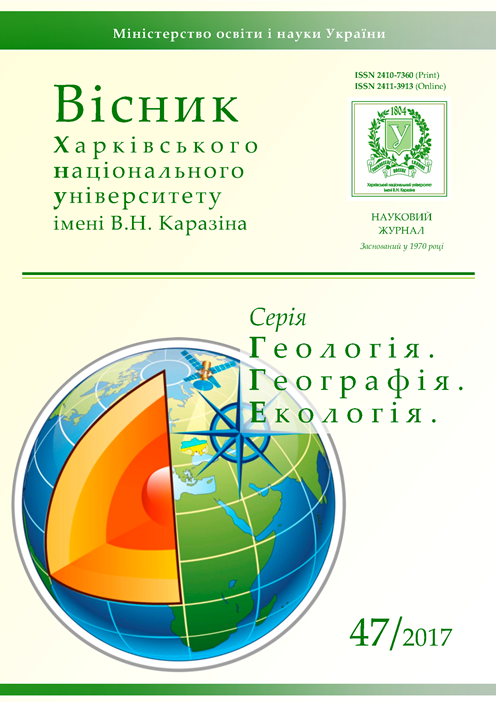Гідрогеодинамічні процеси у карбонатних породах. Частина І. Суфозія
Анотація
Розглянуто гідрогеодинамічні процеси у карбонатних породах мергельно-крейдяної товщі верхньої крейди Святогірської брахіантикліналі. Результатом цих процесів є явища суфозії та карсту. Описано процеси суфозії – як наслідок фізичної (механічної) дії підземних вод на карбонатні породи. Охарактеризовано можливості визначення кількісних показників «твердого стоку», що утворюються в процесі механічного руйнування гірських порід та перенесення твердої мінеральної речовини підземними водами.
Встановлено, що інтенсивність суфозії знаходиться у прямій залежності від об’ємів інфільтраційних вод, що проникають у карбонатні гірські породи у різні періоди року та геоморфологічних особливостей території. Розвитку цього процесу сприяє новітня і сучасна тектонічна активізація Петрівсько-Кремінського розлому, яка обумовлює не лише здіймання південного крила Святогірської брахіантикліналі, а й дезінтеграцію карбонатних мергельно-крейдових порід верхньої крейди. Висхідний тектонічний розвиток рельєфу асоціюється із опуклими схилами, які суттєво переважають у рельєфі «крейдяної брили». Це є причиною зростання потенціалу денудаційних процесів і, відповідно, збільшення впливу потоків інфільтраційних вод на карбонатні породи зони вивітрювання.
Обґрунтовано, що на певному етапі розвитку процесу суфозії спостерігається перехід кількісних змін, пов’язаних з усе більшим подрібненням часток карбонатних порід, у якісні – фізичних (суфозійних) процесів у хімічні (карстові).
Завантаження
Посилання
2. Водообмен в гидрогеологических структурах Украины. Методы изучения водообмена / В. М. Шестопалов,
А. Б. Ситников, В. И. Лялько и др. Отв. ред. В. М. Шестопалов. – Изд. ИГН АН УССР. – Киев : Наук. думка, 1988. – 272 с.
3. Гірничий енциклопедичний словник. Т. 2 / За редакцією В. С. Білецького. – Донецьк : Східний видавничий дім, 2002. – 632 с.
4. Демчишин, М. Г. Інженерно-геологічні умови в долинах рівнинних рік / М. Г. Демчишин, О. М. Анацький // У зб. «Будівельні конструкції». – К. : НДІБК. – 2008. – Кн. 1, вип. 71. – С. 156-164.
5. Ломтадзе, В. Д. Инженерная геология. Специальная инженерная геология / В. Д. Ломтадзе. – Л. : Недра, 1978. – 496 с.
6. Лопатин, Г. В. Эрозия и сток наносов / Г. В. Лопатин // Природа. – 1950. – №7. – С. 19-28.
7. Луговой, В. П. Особенности развития суффозионных явлений на территории с интенсивной техногенной нагрузкой / В. П. Луговой, Ю. С. Остапенко, С. М. Журин, В. В. Сухов // Вісник ХНУ імені В. Н. Каразіна, серія «Геологія–Географія–Екологія». – 1999. – № 455. – С. 65-72.
8. Лущик, А. В. Формирование режима подземных вод в районах развития активных геодинамических процес-сов / А. В. Лущик, Г. В. Лисиченко, Е. О. Яковлев. – К. : Наукова думка, 1988. – 164 с.
9. Методические рекомендации по применению гидрогеохимического метода поисков скрытого оруденения в Донбассе и Днепровско-Донецкой впадине / В. Г. Суярко. – Симферополь : Изд-во ИМР МГ УССР, 1985. –
92 с.
10. Основы гидрогеологии. Геологическая деятельность и история воды в земных недрах / Е. В. Пиннекер, Б. И. Писарский, С. Л. Шварцев и др. – Новосибирск : Наука, 1982. – 239 с.
11. Соколов, А. Д. Закономірності тріщинуватості крейдяних порід долини р. Сіверського Донця / А. Д. Соколов //Доповіді АН УССР, №7. – К. – 1963. – С. 937-940.
12. Сухов, В. В. Инженерно-геологические изыскания в связи с охраной архитектурных памятников в особо сложных природно-техногенных условиях Украины / В. В. Сухов, В. Г. Суярко // Вісник ХНУ імені В. Н. Кара-зіна, серія «Геологія – Географія – Екологія». – 2009. – № 882. – С. 58-64.
13. Сухов, В. В. Инженерно-геологические и гидрогеологические факторы влияния на стабильность историко-архитектурных памятников / В. В. Сухов // Вісник ХНУ імені В. Н. Каразіна, серія «Геологія – Географія – Екологія». – 2012. – № 997. – С. 73-76.
14. Сухов, В. В. Про особливості суфозії карбонатних порід / В. В. Сухов, В. Г. Суярко, О. В. Чуєнко // Вісник ХНУ імені В. Н. Каразіна, серія «Геологія. Географія. Екологія». – 2016. – Вип. 45. – С. 74-79.
15. Сухов, В. В. Про зв’язок сучасних геодинамічних процесів у карбонатних породах з тектонічною активізаці-єю Петрівсько-Кремінського розлому / В. В. Сухов, В. Г. Суярко, О. В. Чуєнко // Вісник ХНУ імені В. Н. Кара-зіна, серія «Геологія. Географія. Екологія». – 2017. – Вип. 46. – С. 56-61.
16. Суярко, В. Г. О современной активизации древних гидротермальных систем / В. Г. Суярко, О. А. Шевчненко // Горный журнал ДНТУ. – Донецк – 1996. – № 2(4). – С. 95-97.
17. Суярко, В. Г. Геохимия подземных вод восточной части Днепровско-Донецкого авлакогена / В. Г. Суярко. – Харьков : ХНУ имени В. Н. Каразина, 2006. – 225 с.
18. Суярко, В. Г. Концептуальна синергетична геолого-гідрогеологічна модель розвитку суфозії та карсту у карбонатних породах на території Святогірського монастиря / В. Г. Суярко, В. В. Сухов // Вісник ХНУ імені В. Н. Каразіна, серія «Геологія. Географія. Екологія». – 2015. – № 1157. – С. 63-68.
19. Fournier, F. Climatel erosion / F. Fournier. – Press Universitaries de France. – Paris, 1960. – 120 p.
20. Moffat, R. Hydromechanical model for internal erosion and its relationship with the stress transmitted by the finer soil fraction / Ricardo Moffat, Paulo Herrera // Acta Geotechnica, 2015. – Springer Heidelberg, Germany. – Vol. 10, 5. – P. 643-650. DOI: 10.1007/s11440-014-0326-z
21. Slangen, P. The role of particle type on suffusion and suffusion / P. Slangen, R. J. Fannin // Geotechnique Letters, 2017. – Ice Publishing: England –Vol. 7, 1. DOI: 10.1680/jgele.16.00099
22. Slangen, P. A Flexible Wall Permeameter for Investigating Suffusion and Suffosion / P. Slangen, R. J. Fannin // Geotechnical Testing Journal, 2017. – Amer Soc Testing Materials, USA. – Vol. 40, 1. – P. 1-14. DOI: 10.1520/GTJ20150287
23. Ouyang, M. Optical quantification of suffusion in plane strain physical models / M. Ouyang, A. Takahashi // Ge-otechnique Letters, 2017. – Ice Publishing: England –Vol. 5, 3. – P. 118-122. DOI: 10.1680/geolett.15.00038





